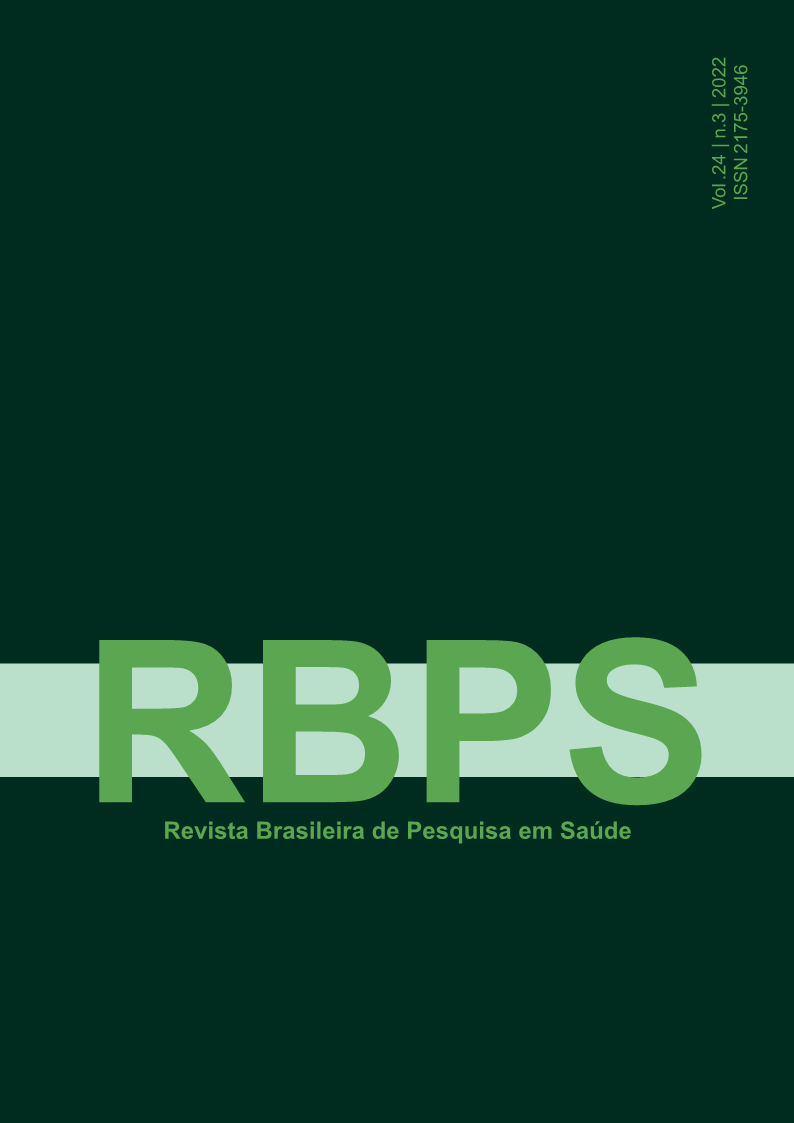Chikungunya, a growing epidemic and its alternative treatments
DOI:
https://doi.org/10.47456/rbps.v24i3.38413Keywords:
Chikungunya, Integrative and complementary practices, Chronic painAbstract
Introduction: Arboviruses transmitted by the genus Aedes aegypti are one of the leading public health problems today, one of them being the Chikungunya virus, which is presenting a growing portion of this problem. Therefore, looking at other treatment options widens the feasibility of improving the quality of life of those affected by this virus. Objectives: To identify surveys published on current scientific bases that corroborate the benefits of integrative and complementary practices in treating symptoms arising from the chronic phase of chikungunya fever. Methods: Integrative review following the Joanna Briggs Institute methodology, carried out in the health sciences databases Scielo, Google Academic, Pubmed, Elsevier, ScienceDirect, Lilacs and Scopus. Using keywords “chikungunya”, “BioFAO method”, “acupuncture”, and “ginger”, among other words. Searches in Portuguese, Spanish, and English; as publishings between the years 2015 to 2022. Results: Among the analyzed studies and data it was observed that the treatments addressed in the present review show evidence of benefits in favor of well-being and improvement of the symptoms of the chronic phase of the Chikungunya virus. Conclusion: It is possible to determine that the indication and prescription of complementary treatments such as acupuncture, medicinal plants, and BioFAO homeopathy, can be beneficial in helping to control the symptoms of chikungunya in its chronic phase, as well as promoting improvement in the quality of life of patients afflicted with the chronic pain of Chikungunya fever.
Downloads
References
Donalisio MR, Freitas ARR. Um desafio emergente. Revista Brasileira de Epidemiologia. 2015;18(1):283-305.
Brasil. Febre de Chikungunya manejo clínico. Ministério da Saúde. Secretaria de Vigilância em Saúde. 2015;28.
Brasil. Monitoramento dos casos de arboviroses até a semana epidemiológica 9 de 2022. Boletim Epidemiológico Arboviroses. 2022;53(9):1-21.
Finnerup NB, Attal N, Haroutounian S, McNicol E, Baron R, Dworkin RH, et al. Pharmacotherapy for neuropathic pain in adults: A systematic review and meta-analysis. Lancet Neurol. 2015;14(2):162-73.
Brasil. Manual de Implantação de Serviços de Práticas Integrativas e Complementares no SUS [Internet]. Brasília: Ministério da Saúde; 2018. Disponível em: http://189.28.128.100/dab/docs/portaldab/publicacoes/ manual_implantacao_servicos_pics.pdf
Peters M., Godfrey C., McInerney P. Baldini Soares C., Khalil H., Parker D. The Joanna Briggs Institute Reviewers’. Manual 2015: Methodology for JBI scoping reviews. Joanne Briggs Inst [Internet]. 2015;1-24. Available from: http://joannabriggs.org/assets/docs/ sumari/ReviewersManual_Mixed-Methods-Review- Methods-2014-ch1.pdf
Brasil. Ministério da Saúde. Secretaria de Vigilância em Saúde. Guia de Vigilância em Saúde. Brasília: Ministério da Saúde; 2019.
Madariaga M, Ticona E, Resurrecion C. Chikungunya: Bending over the Americas and the rest of the world. Brazilian J Infect Dis. 2016;20(1):91-8.
Cerroni MP, Carmo EH. Magnitude das doenças de notificação compulsória e avaliação dos indicadores de vigilância epidemiológica em municípios da linha de fronteira do Brasil, 2007 a 2009. Epidemiologia e Serviços Saúde. 2015;24(4):617-28.
Castro APCR, Lima RA, Nascimento J dos S. Chikungunya: vision of the pain clinician. Rev Dor. 2016;17(4):299-302.
Bandeira AC, Campos GS, Rocha VFD, Souza BSF, Soares MBP, Oliveira AA, et al. Prolonged shedding of Chikungunya virus in semen and urine: A new perspective for diagnosis and implications for transmission. IDCases [Internet]. 2016;6:100-3. Available from: http://dx.doi. org/10.1016/j.idcr.2016.10.007
Johnson BW, Russell BJ, Goodman CH. Laboratory diagnosis of chikungunya virus infections and commercial sources for diagnostic assays. J Infect Dis. 2016;214(Suppl 5):S471-4.
de Carvalho JF, Kanduc D, da Silva FF, Tanay A, Lucchese A, Shoenfeld Y. Sjögren’s Syndrome Associated with Chikungunya Infection: A Case Report. Rheumatol Ther. 2021;8(1):631-7.
Cruz JCG, Moreno CB, Colombo-Barboza GN, Colombo-Barboza MN. Anterior scleritis treated with systemic corticosteroids in Chikungunya infection. Am J Ophthalmol Case Reports [Internet]. 2022 Jun 26(January):101555. Available from: https://linkinghub. elsevier.com/retrieve/pii/S2451993622003012
Hucke FIL, Bugert JJ. Current and Promising Antivirals Against Chikungunya Virus. Front Public Heal. 2020;8:1-23.
Telesi Júnior E. Práticas integrativas e complementares em saúde, uma nova eficácia para o SUS. Estudos Avançados. 2016;30(86):99-112.
Alves JA. Práticas integrativas e complementares em saúde na prevenção, controle e tratamento das arboviroses Dengue, Zika e Chikungunya: uma sistematização qualitativa, Brasil 2019 [dissertação]. Brasília: Universidade; 2020. Disponível em: https://repositorio.unb.br/ handle/10482/39724
Brasil. Portaria n° 849, de 27 de março de 2017. Inclui a Arteterapia, Ayurveda, Biodança, Dança Circular, Meditação, Musicoterapia, Naturopatia, Osteopatia, Quiropraxia, Reflexoterapia, Reiki, Shantala, Terapia Comunitária Integrativa e Yoga à Política Nacional de Práticas Integrativas e Complementares. 2017. Disponível em: https://bvsms.saude.gov.br/bvs/saudelegis/gm/2017/ prt0849_28_03_2017.html.
Kriplani P, Guarve K, Baghael US. Arnica montana L. – a plant of healing: review. J Pharm Pharmacol. 2017;69(8):925-45.
Brasil. Formulário de Fitoterápicos da Farmacopeia Brasileira. 2. ed. Brasília: Ministério da Saúde; 2018. Disponível em: https://www.gov.br/anvisa/pt-br/assuntos/ farmacopeia/formulario-fitoterapico/2022-fffb2-versao- 13-mai-2022.pdf
Marchi JP, Tedesco L, Melo ADC, Frasson AC, França VF, Wietzikoski SS, et al. O açafrão da terra, e seus benefícios medicinais. Arq Ciências da Saúde da UNIPAR. 2016;20(3):189-94.
da Silva FMA, da Silva KPA, de Oliveira LPM, Costa E V., Koolen HHF, Pinheiro MLB, et al. Flavonoid glycosides and their putative human metabolites as potential inhibitors of the sars-cov-2 main protease (Mpro) and rna-dependent rna polymerase (rdrp). Mem Inst Oswaldo Cruz. 2020;115(9):1-8.
Régis MA, Rosendo RA, Medeiros LADM, Fook MVL, Barbosa RC, Figueiredo ABM, et al. Desenvolvimento e caracterização de esferas de quitosana/ Dysphania ambrosioides (L.) Mosyakin & Clemants. Matéria. 2020;25(4).
Kaushik S, Jangra G, Kundu V, Yadav JP, Kaushik S. Anti-viral activity of Zingiber officinale (Ginger) ingredients against the Chikungunya virus. VirusDisease. 2020;31:270-6.
Acar HV. Acupuncture and related techniques during perioperative period: A literature review. Complement Ther Med. 2016;29:48-55. Available from: http://dx.doi. org/10.1016/j.ctim.2016.09.013
Coutinho BD. Efeitos da Auriculoterapia na Dor e Limitação da Mobilidade de Indivíduos com Febre Chikungunya [tese]. Belo Horizonte: Universidade Federal de Minas Gerais; 2018.
Hou PW, Hsu HC, Lin YW, Tang NY, Cheng CY, Hsieh CL. The history, mechanism, and clinical application of auricular therapy in traditional Chinese medicine. Evidence-based Complement Altern Med. 2015;2015.
Oliveira UBG, Fé MAM. Auriculoterapia na atenção básica: uma estratégia complementar de cuidado da febre chikungunya no município de Floriano-PI [trabalho de conclusão de curso]. Universidade Federal do Piauí; 2019. Disponível em: https://ares.unasus.gov.br/acervo/handle/ ARES/13723
Downloads
Published
How to Cite
Issue
Section
License
Copyright (c) 2022 Brazilian Journal of Health Research

This work is licensed under a Creative Commons Attribution-NonCommercial-NoDerivatives 4.0 International License.





